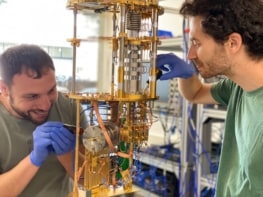
Microscopic devices made from so-called Janus particles can be made to “swim” through liquid with the help of light-induced thermoelectric fields. The devices, which can travel 100μm along a straight course in 39 seconds, might find applications in biomedical sensing and the targeted, non-invasive delivery of drugs, according to developers at the University of Texas at Austin, US.
Janus particles – named for the famously two-faced Roman god of beginnings and transitions – are tiny spheres coated with different materials on each side. With the right choice of coatings, such particles will act as “microswimmers”, travelling in a specific direction when placed in a chemical solution and driven by light, magnetic, electric or ultrasonic fields.
Light-driven microswimmers are particularly promising for applications inside the body, as they can be controlled remotely with high spatial and temporal resolution. Their chief drawback is that their direction of travel becomes increasingly erratic over time thanks to rotational Brownian motion – the random motion of particles suspended in a medium.
Asymmetric photothermal response
In designing their microswimmers, Yuebing Zheng and colleagues found a way of overcoming this problem. The researchers made the microswimmers by covering a glass substrate with a single layer of pristine polystyrene beads using a technique called spin coating. They then used physical vapour deposition to cover one side of the beads with a gold film. The resulting Janus particles were freely dispersed in an aqueous solution containing a cation surfactant called CTAC. This surfactant makes the beads positively charged, while also introducing spherical fatty molecules, or micelles, of CTAC into the solution along with Cl– ions.
While the gold sides of the Janus particles heat up when illuminated with laser light, the uncoated sides do not. The temperature gradient thus produced redistributes the CTAC micelles and Cl– ions, causing an electric field to build up around the charged particles. According to Zhihan Chen, the study’s co-first author, this opto-thermoelectric force plays a key role in determining the particle’s behaviour.
Comparison with swimming microorganisms
When the researchers illuminated the particles with de-focused laser light, the particles swam in the direction of the optothermally-generated light fields. When they switched to a focused laser beam, however, the particles rotated in-plane. The combination of linear travel and rotations is similar to the “run-and-tumble” motion of swimming microorganisms such as E. Coli bacteria, and it can be maintained thanks to the balance between the opto-thermoelectric, optical and Stokes drag forces.
To keep their Janus particles moving in the right direction, Zheng and colleagues developed a feedback control algorithm to switch between the particles’ swimming and rotating states. By carefully observing the particles in real time, the researchers were able to adjust their control algorithm to make it automatically set the particles rotating whenever they deviate from the desired path. Once the particles realign, the algorithm re-activates their swimming state. Through repeated switching between states, the researchers showed that they could make the Janus particles travel in a straight line – behaviour that could be exploited for non-invasive drug delivery in the body, Chen says.
Improving navigation efficiency
The researchers, who report their work in Light: Science & Applications, now plan to improve the navigation efficiency of their microbots. “In our present study, we showed that 5-μm microswimmers can directionally transport over 110 μm in 39 seconds, but we would like to double this figure and deliver the particles over the same distance in just 18 seconds,” Chen says. “We could achieve this by further improving the response time of our imaging camera and laser shutters.”

Microswimmers manipulate single particles and cells
The team also plan to further develop their control algorithm so it can steer multiple particles at the same time, while also adding non-collision and path optimization functions.
The half-gold, half-uncoated Janus particles studied in this work are a common type, but in the future, Zheng and colleagues hope to functionalize their polystyrene beads by loading macromolecules onto their uncoated surfaces. “This strategy would enable efficient and targeted cargo delivery totally driven by light,” Chen tells Physics World.



